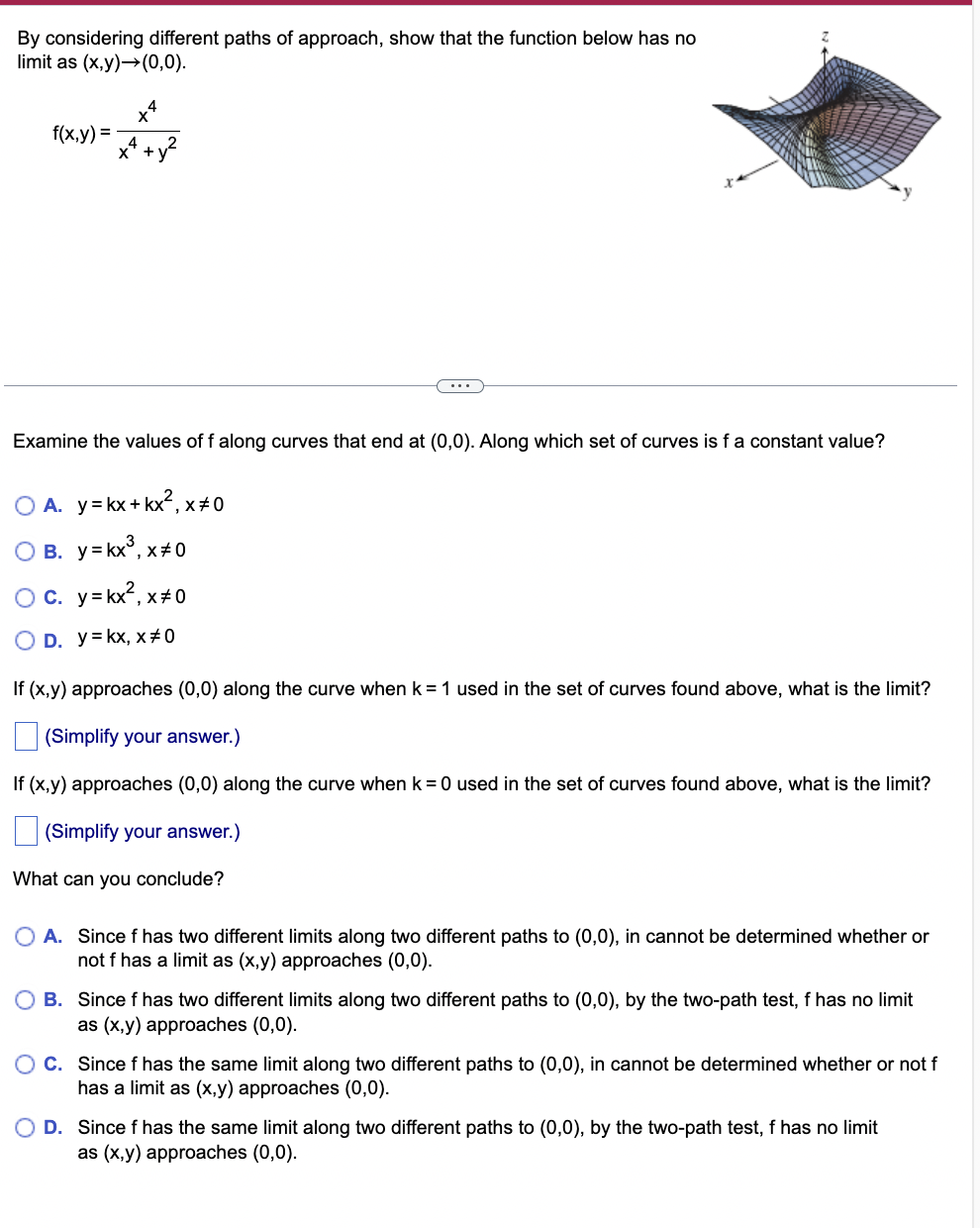By considering different paths of approach, show that the function below has no limit as (x,y)→(0,0). f(x,y) = x x ... Examine the values of f along curves that end at (0,0). Along which set of curves is f a constant value? OA. y = kx + kx², x*0 B. y=kx³, x #0 O C. y = kx², x#0 O D. y=kx, x #0 If (x,y) approaches (0,0) along the curve when k = 1 used in the set of curves found above, what is the limit? (Simplify your answer.) If (x,y) approaches (0,0) along the curve when k = 0 used in the set of curves found above, what is the limit? (Simplify your answer.) What can you conclude? O A. Since f has two different limits along two different paths to (0,0), in cannot be determined whether or not f has a limit as (x,y) approaches (0,0). OB. Since f has two different limits along two different paths to (0,0), by the two-path test, f has no limit as (x,y) approaches (0,0).
By considering different paths of approach, show that the function below has no limit as (x,y)→(0,0). f(x,y) = x x ... Examine the values of f along curves that end at (0,0). Along which set of curves is f a constant value? OA. y = kx + kx², x*0 B. y=kx³, x #0 O C. y = kx², x#0 O D. y=kx, x #0 If (x,y) approaches (0,0) along the curve when k = 1 used in the set of curves found above, what is the limit? (Simplify your answer.) If (x,y) approaches (0,0) along the curve when k = 0 used in the set of curves found above, what is the limit? (Simplify your answer.) What can you conclude? O A. Since f has two different limits along two different paths to (0,0), in cannot be determined whether or not f has a limit as (x,y) approaches (0,0). OB. Since f has two different limits along two different paths to (0,0), by the two-path test, f has no limit as (x,y) approaches (0,0).
College Algebra (MindTap Course List)
12th Edition
ISBN:9781305652231
Author:R. David Gustafson, Jeff Hughes
Publisher:R. David Gustafson, Jeff Hughes
Chapter2: Functions And Graphs
Section2.6: Proportion And Variation
Problem 18E
Related questions
Question

Transcribed Image Text:By considering different paths of approach, show that the function below has no
limit as (x,y)→(0,0).
f(x,y) =
x
x
...
Examine the values of f along curves that end at (0,0). Along which set of curves is f a constant value?
O A. y = kx + kx², x*0
B. y=kx³, x #0
O C. y = kx², x#0
O D. y=kx, x #0
If (x,y) approaches (0,0) along the curve when k = 1 used in the set of curves found above, what is the limit?
(Simplify your answer.)
If (x,y) approaches (0,0) along the curve when k = 0 used in the set of curves found above, what is the limit?
(Simplify your answer.)
What can you conclude?
O A. Since f has two different limits along two different paths to (0,0), in cannot be determined whether or
not f has a limit as (x,y) approaches (0,0).
O B. Since f has two different limits along two different paths to (0,0), by the two-path test, f has no limit
as (x,y) approaches (0,0).
OC. Since f has the same limit along two different paths to (0,0), in cannot be determined whether or not f
has a limit as (x,y) approaches (0,0).
O D. Since f has the same limit along two different paths to (0,0), by the two-path test, f has no limit
as (x,y) approaches (0,0).
Expert Solution
This question has been solved!
Explore an expertly crafted, step-by-step solution for a thorough understanding of key concepts.
Step by step
Solved in 5 steps with 5 images

Recommended textbooks for you

College Algebra (MindTap Course List)
Algebra
ISBN:
9781305652231
Author:
R. David Gustafson, Jeff Hughes
Publisher:
Cengage Learning

College Algebra (MindTap Course List)
Algebra
ISBN:
9781305652231
Author:
R. David Gustafson, Jeff Hughes
Publisher:
Cengage Learning